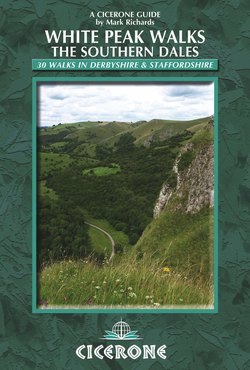Читать книгу White Peak Walks: The Southern Dales - Mark Richards - Страница 13
ОглавлениеWALK 5
Manifold Track and Ecton Hill
| Start/Finish | Hulme End |
| Distance | 8.5km (5¼ miles) |
| Time | 4hrs |
| Terrain | A modestly hilly walk, with two steep ascents and descents, all the time on firm paths; the walk begins and ends with soothing strides along the level trackbed trail. |
| Refreshments | The Manifold Inn at Hulme End and Wettonmill Café |
| Parking | (GR 103593) Hulme End National Park Authority car park (pay and display) and picnic site, at northern end of Manifold Track and former light railway station, now popular cycle hire centre |
Although created as long ago as 1937 the Manifold Track is still one of the prime visitor attractions of the White Peak, and is particularly welcomed by those who have young children in pushchairs or who are confined to wheelchairs or lack the vigour of their youth. Hulme End, the former terminal of the Leek and Manifold Light Railway, provides the perfect springboard not merely to sample the Track but also to explore Ecton Hill with its heritage of copper mining.
Follow the track south to Dale Bridge. Leave the Track, rising left with the minor road. Cross the road junction and ascend the metalled lane to Radcliffe’s Castle, presently enveloped in scaffolding. Today Ecton is a quiet place, but during the 17th and 18th centuries it was subjected to the frenzy of copper fever. Evidence of those years’ activity can be seen today in the form of spoil (although a great deal was removed and used as ballast for the railway). The walk passes two buildings surviving from those days on the rise to Radcliffe’s folly castle: a former sales office and the mine agent’s (captain’s) house.
Radcliffe’s Folly is a classic example of pre-planning regulation eccentricity. Despite its copper hood this oddity has no links with Ecton’s mining days, having been shoddily built in the 1930s by Arthur Radcliffe.
MINING ACTIVITY ON ECTON HILL
Visitors who have delighted in the grandeur of Chatsworth House and Buxton Spa would do well to consider from where much of the wealth for their creation derived. The productivity of Ecton Hill’s copper, lead and zinc deposits (though prone, like all mining ventures, to great variation) tended to reach its zenith whenever the Dukes of Devonshire desired funding for their various building enterprises, the increasingly rich pickings probably prompting equally big ideas! During the heyday years in the latter half of the18th century the principal beneficiaries were the Devonshires (from Ecton Pipe Vein) and the Burgoynes (from Clayton Pipe Vein). The 19th century saw an appreciable decline in the ventures due to flooding and the likely exhaustion of easily obtainable ore. The horseshoe of conifers seen on the ascent from the Folly surrounds the spoil from the Dutchman Level (the level is blocked, though easily located by the spring of water). The ruins here are of an engine house, smithy and carpenter’s shop used chiefly during the construction of the Goodhope Level in the 1850s. Above this is a barn adapted for farm use but which was erected in 1788 to house a Boulton & Watt steam engine, which raised ore and pumped water from the Deep Ecton Mine. When sunk in the years to 1795 the shaft was the deepest in Britain, being some 282m (924ft) feet below adit level (by 1840 the shaft from the surface was 400m/1312ft deep, hence my warning about the open top below). Speleological access is strictly controlled.
Pass through the archway to a wall-stile left. Proceed along the path, mounting the steep scarp obliquely beneath the mine spoil plantation and above the scree quarry. The views throughout this section are quite delightful and frequent halts are in order, the severity of the slope dictating that walkers keep their eyes resolutely on the narrow trod whilst actually moving!
Coming onto a shoulder look down on Swainsley House with its riverside dovecote. At the crest, contour to a short hedge rising to a stile. Traverse the open pasture (some walls have been removed, antiquating the OS map); glance by a projecting wall corner, at which point aim half-right to a gateway. Go through and continue below Summerhill Farm to a wall-stile and gate. Bear left with a wall left to reach a wall-stile gaining entry into a lane from Broad Ecton.
Swainsley House and the Manifold valley from Ecton Hill
Turn right, and as the track bends left go through the wicket-gate on the right. The path follows the wall down the shallow dale, passing through a rustic drum-stile and loose gate from where the dale narrows. Advancing to switch sides of the dale wall coming above scrub to slip through a wall squeeze-stile (NT Dale Farm sign). The path smartly encounters a fence-stile and descends a loose trod in the woodland beside the great limestone bluff of Sugar Loaf to enter the open pasture of the nameless dale. A delightful stroll down the wood-flanked meadow ensues to pass through a gate and through the farmyard at Dale Farm, continuing on the lane to Wettonmill Bridge.
